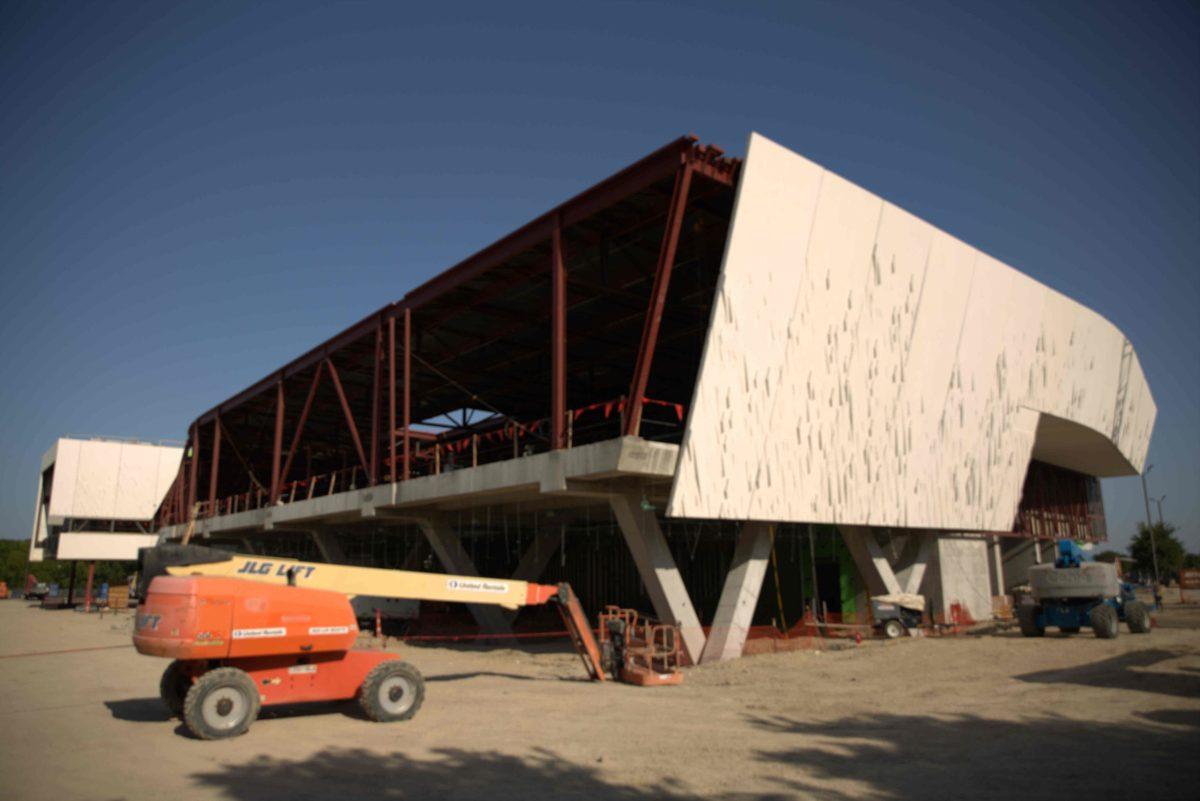The first phase of the Athenaeum, also known as the Crow Museum of Asian Art at UTD, is currently undergoing construction and will be open to the public on Aug. 19, 2024.
According to Senior Director Amy Hofland, the 68,000 square foot museum located to the south of JSOM began design and construction in 2019 when the Crow family — a pioneer in Asian arts — donated $25 million for the construction of a new building on campus. The museum consists of art pieces including but not limited to sculptures, bronze ware, and scrolls from East, Southeast and South Asia dating from 5000 BC to the present day. Hofland added that the museum will be open to the public for free, in accordance with the founders’ wishes.
“We most recently had a beam signing and we’re in a process now of completing the addition of the panels with the hope of having the entire space conditioned later this fall,” said Calvin Jamison, vice president for facilities and economic development. “The first phase… will be completed [in] the spring of ’24, and actual occupancy will take place during the summer.”
The museum, which was designed by Morphosis Architects and led by principal architect Arne Emerson — also the project architect for the Perot Museum of Nature and Science in downtown Dallas — is accompanied by a 1,100-space parking lot and is currently undergoing construction.
“We have 10 foot by 30 foot precast concrete structures that are being hung on the steel armature that create the wall of the museums,” Hofland said. “Morphosis designed a tessellation pattern that’s based on an Asian design. When you look closely, you’ll see it in the sunlight, it will sparkle like a pearl on campus, which I’m very excited about.”
The museum will include a large event space under a canopy on the first floor and galleries on the second floor, a loan from the Modern Art Museum of Fort Worth in the lobby, followed by a staircase leading to the Crow gallery on its left and Bar gallery on the right. The second floor will also house a seminar room for workshops along with the Richard Brettell reading room.
“[The Bar gallery is] the complementary section of the museum that will hold a partnership installation with the Dallas Museum of Art, so we’re bringing some of the treasures of our local city’s art museum,” Hofland said. “In an exhibition curated by Dr. Michael Thomas at the Edith O’Donnell Institute of Art History… it will celebrate the gifts of the Jonsson, Green, and McDermott families to the Dallas Museum of Art.”
The remaining space in the Bar gallery will be used for an incubator exhibition of Latin American art, which Hofland believes will be the second museum in the Athenaeum. The Crow gallery will showcase older art from religions still alive today, including Hinduism and Buddhism, infused with traditions of East, Southeast, and South Asian cultures. Hofland added that the museum will include a jade room — “a heartbeat of the collection” — which will comprise works that incorporate jade, a gemstone and symbol of prosperity in Chinese culture. Additionally, there are plans in the future to add an exhibition showcasing Islamic art as well.
“Our former curator, Jacqueline Chao, has written a new handbook for all of the opportunities we see here at UT Dallas academically,” she said. “It will give a little bit of history and a lot of overview of how the collection spans time and geography and religious and cultural contexts. As a technology campus, it’s really important that we are on the daring edge of how technology enhances the visitor experience so we’re partnering with the Bass school to work with students … where we’ll present digital works of art.”
Hofland said she and Natalia Di Pietrantonio, the Crow Museum’s new curator, are currently working on the visitor experience and tying it back to the museum’s theme of compassion and wonder. She also hopes that students, staff, and the public can hold and teach workshops, such as tai chi or ceramics, to destress from the busy world.
“We don’t have time or space to wonder much, especially as a busy student, so can this museum be your place for sort of taking a deep breath and really asking questions,” Hofland said. “We want our exhibitions to feel like you need to see them because what I want [is] the next time you visit to be a little bit different, and I think technology will help us create that kind of sense of urgency. I want this to be a portal to the world and so I believe these exhibitions will be so important for us to initiate dialogues.”
Hofland said that the museum will open doors to student employment including but not limited to a student advisory board, a student docent program, and student internship programs. She added that the museum will help students honor the intricacies of Asian art and culture regardless of their heritage. While Phase I will continue to undergo construction throughout the year, Phase II of the Athenaeum — a 680-seat performance hall — will simultaneously undergo construction as well.
“We’re in the process now of designing this building [the performance hall] and adding it to the CIP, or capital improvement projects for the Board of Regents approval,” Jamison said. “The goal would be that this would be completed in the spring of ’26. The fact that there will be an arts district that’s anchored by a museum, a performance hall, and a plaza by which students, faculty and staff will have access is an extremely strong attraction for persons who are considering UTD as a STEAM university.”





